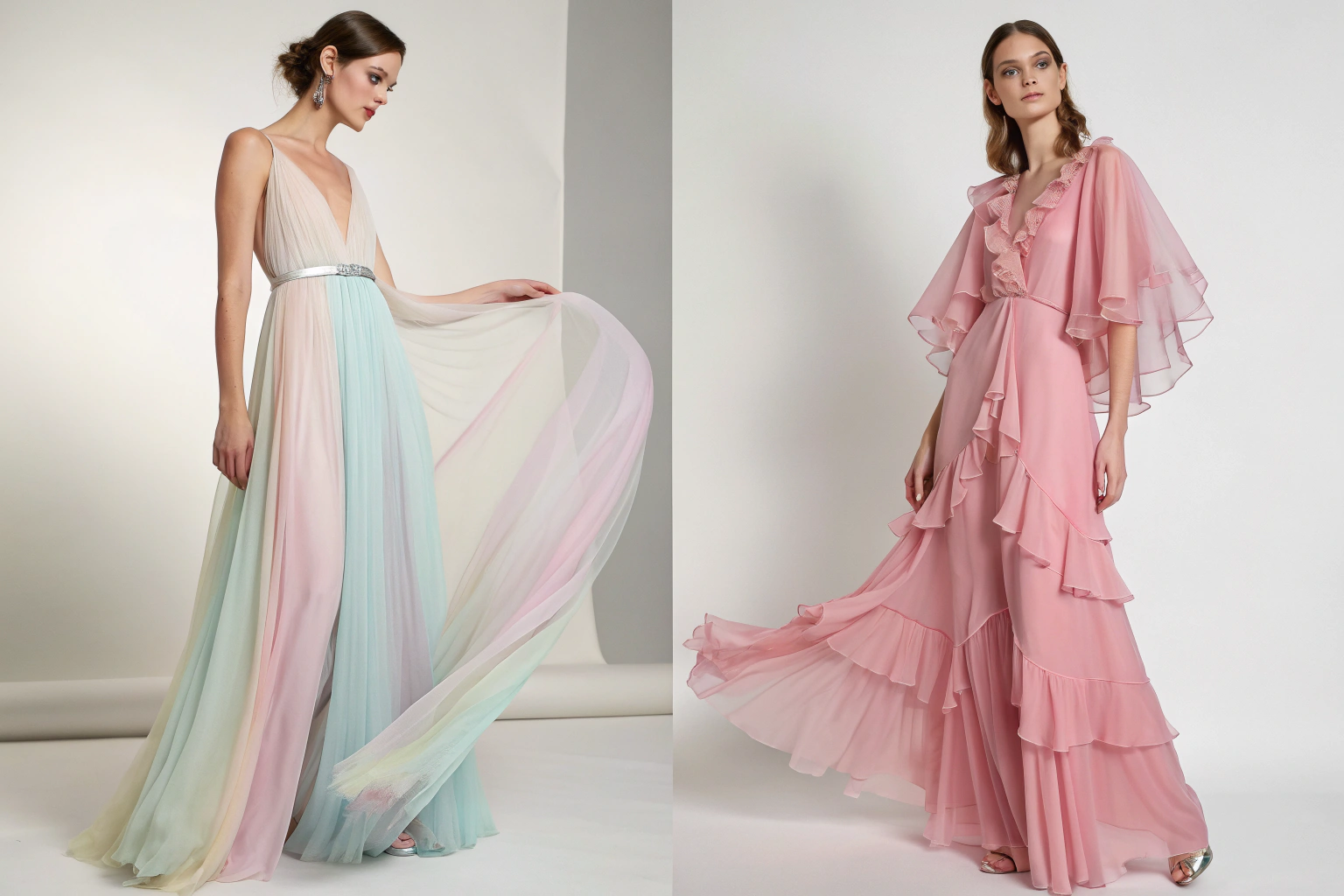When shoppers, designers, or sourcing managers select fabrics for dresses, two names repeatedly surface: chiffon and georgette. These textiles dominate the fashion world because of their flow, versatility, and aesthetic appeal. Yet, confusion often arises because they share similarities while catering to very different needs. Buyers who make the wrong choice risk ending up with dresses that either look too fragile for daily use or too rigid for a special occasion.
Chiffon is often considered the queen of elegance—light, sheer, and ideal for ethereal gowns—while georgette is the reliable all-rounder, offering strength, drape, and adaptability for both formal and everyday wear. Knowing which fabric fits best requires analyzing texture, durability, care needs, and the occasions where each performs best.
As a professional fabric manufacturer and exporter with 20+ years of experience, I will give you a detailed comparison of chiffon and georgette so you can make an informed choice, whether you are a designer creating a bridal collection, a buyer sourcing for boutiques, or an entrepreneur planning your own label.
What Are the Key Differences Between Chiffon and Georgette?
Many first-time buyers think chiffon and georgette are interchangeable because both are lightweight and drapey. But they differ in yarn twist, texture, and durability. These technical differences drastically change how the final dress looks and feels.
The biggest difference is that chiffon has a smooth, glossy surface and extreme lightness, while georgette has a crinkled texture and slightly more weight, giving it structure and durability. Designers use chiffon when aiming for dreamy elegance and georgette when they want versatile wearability.
Chiffon is often woven from fine silk or polyester filament yarns, which makes it sheer and soft to the touch. Georgette, on the other hand, uses twisted crepe yarns, giving it a pebbly texture. That is why chiffon flows like mist, while georgette holds gentle ripples.
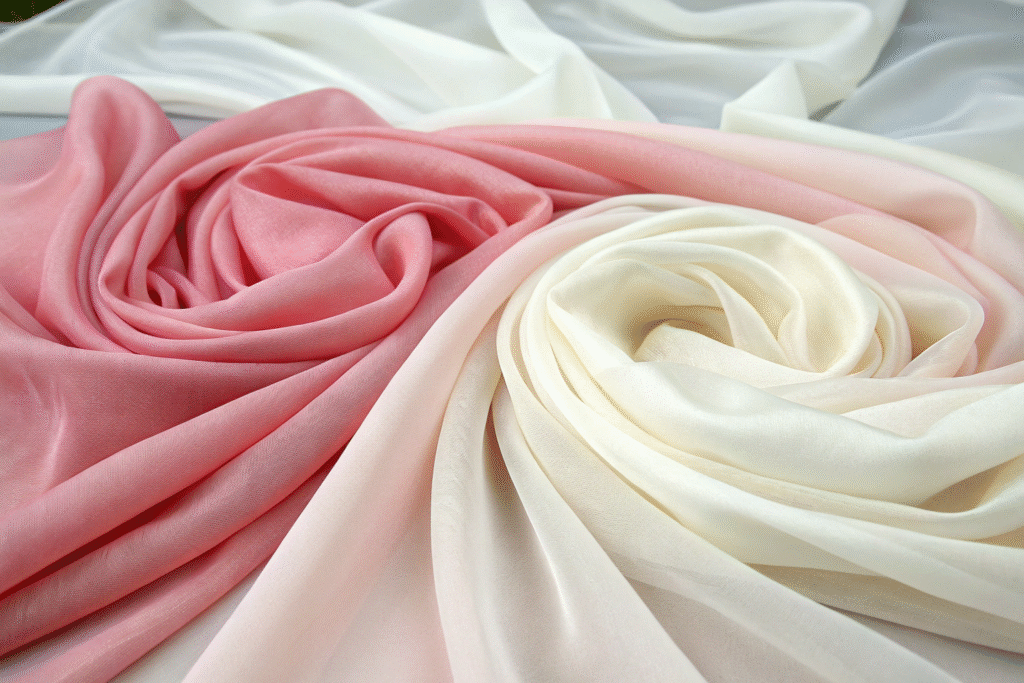
Why Is Chiffon Considered More Elegant?
Chiffon’s reputation for elegance comes from its transparency and airy feel. When layered, chiffon dresses resemble floating clouds. This is why it dominates evening gowns and high-end couture. For example, Elie Saab and Dior frequently use chiffon in red-carpet gowns to achieve volume without heaviness.
At weddings, chiffon veils and layered skirts remain timeless. According to The Knot, chiffon is one of the top bridal fabric choices because it looks romantic and photographs beautifully outdoors. The drawback is its fragility—chiffon snags easily on jewelry and needs lining with sturdier fabrics like satin.
Why Do Many Designers Prefer Georgette for Everyday Wear?
Georgette may lack chiffon’s shimmer, but it makes up for it with practicality. Because of its tighter weave and textured finish, georgette is less transparent and doesn’t need as much lining. Designers love this when creating day-to-night dresses, office wear, or cocktail attire.
For example, Vogue’s ready-to-wear collections often showcase georgette dresses that carry embroidery, sequins, and pleats. The fabric handles embellishments better than chiffon because its structure supports weight without sagging. Many Indian designers also use georgette in sarees and lehengas, proving its global adaptability.
Which Fabric Is Easier to Care for in Dresses?
Maintenance is a decisive factor for many buyers. Customers in markets like the U.S. or Europe often demand fabrics that are stylish but easy to wash and keep in shape. Here, chiffon and georgette differ dramatically.
Georgette is more practical to care for because it resists wrinkles and tears better, while chiffon requires delicate handling and is often dry-clean only. This care difference affects buyer satisfaction, especially in large-scale exports.
Think of it this way: chiffon is like a luxury sports car—it’s stunning but high-maintenance. Georgette is more like a reliable SUV—stylish but also built to endure regular wear.
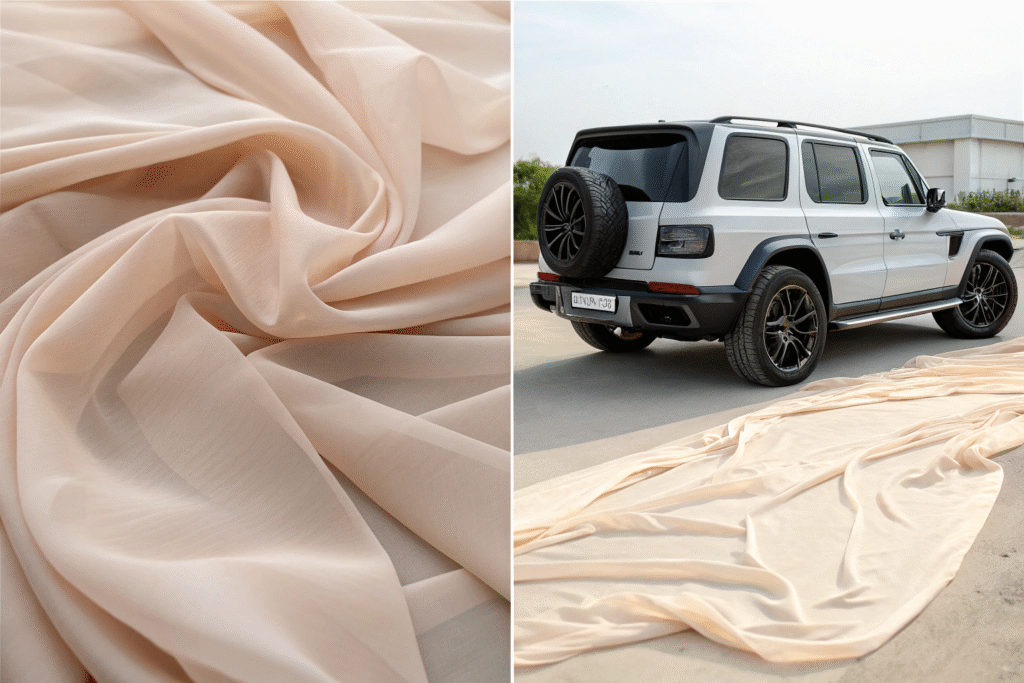
Can Chiffon Dresses Be Machine Washed?
Generally, chiffon dresses should not be machine washed because the agitation damages the fine yarns. Martha Stewart’s fabric care guide recommends hand washing in cold water with mild soap. Even then, the fabric may fray at edges or lose its crisp drape.
Some polyester chiffon blends can survive a delicate cycle if placed in a mesh bag, but silk chiffon almost always requires professional dry cleaning. This makes chiffon less attractive for mass-market buyers who prioritize ease of care.
Why Is Georgette Considered More Practical for Maintenance?
Polyester georgette, in particular, is highly resistant to shrinking and wrinkling. The Spruce notes that most georgette dresses can be washed at home, provided they are placed on delicate settings. Compared to chiffon, georgette withstands travel better, making it popular among working professionals and fashion retailers who need garments to look fresh off the rack.
For wholesalers and resellers, this means fewer returns and higher customer satisfaction. The practicality of georgette makes it ideal for mid-market and premium brands seeking balance between elegance and usability.
Which Fabric Works Best for Special Occasions?
Occasion plays a key role in choosing chiffon or georgette. While both can be styled for formal and casual use, their strengths shine in different settings.
Chiffon dominates in weddings and luxury gowns, while georgette rules in cocktail, party, and multipurpose dresses. Many designers even layer chiffon on top of georgette to combine elegance with durability.
This hybrid approach has gained popularity in export markets, where consumers seek glamour without sacrificing wearability.
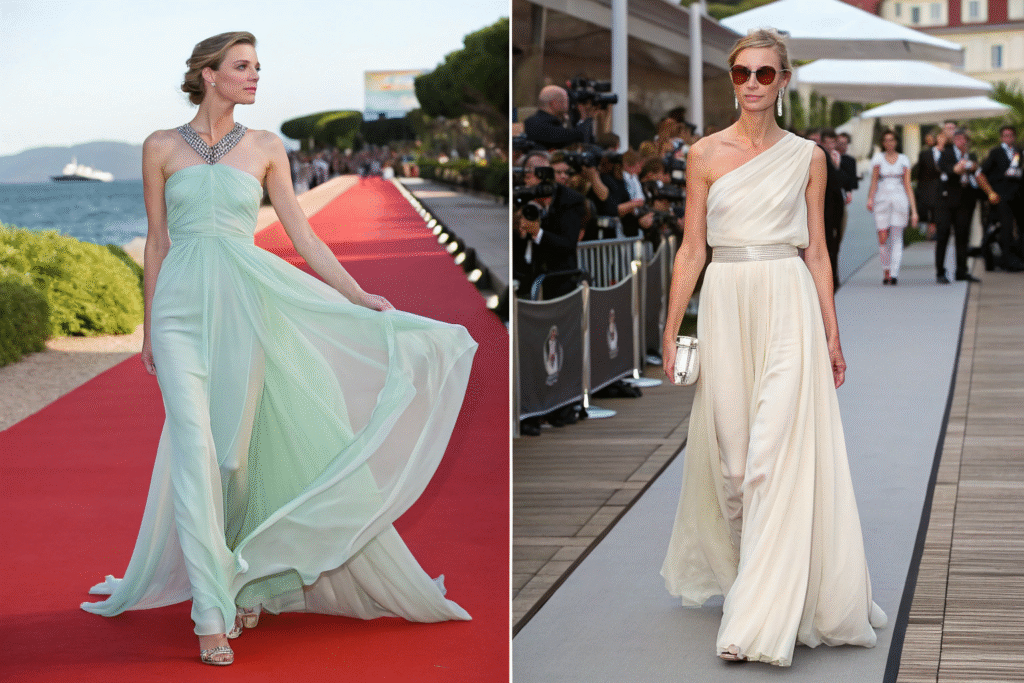
Why Do Brides Often Choose Chiffon?
Brides frequently pick chiffon for its soft, flowing layers. A chiffon wedding gown moves beautifully in wind and photographs well in natural light. According to Brides Magazine, chiffon is a top choice for destination weddings because it is breathable and easy to layer.
Luxury houses like Valentino and Elie Saab often rely on chiffon for long trains, veils, and overlays. Still, its fragility means chiffon wedding dresses often require professional preservation after the event.
Why Do Party Wear and Cocktail Dresses Use More Georgette?
Georgette has earned its reputation as the go-to party fabric because it holds embellishments like sequins, beads, and embroidery. Designers from India Retailing note that georgette sarees and gowns dominate festive wear markets.
The fabric’s body allows sharp pleats and structured drapes, which are perfect for cocktail dresses and evening events. Buyers also appreciate that georgette can be packed in a suitcase without losing shape, making it ideal for travelers.
Which Fabric Should You Choose for Your Next Dress?
The answer depends on your design goals, market needs, and customer lifestyle. Both chiffon and georgette bring value, but they serve different purposes.
If you need ethereal beauty, go with chiffon. If you want practicality and structure, choose georgette. For a balanced option, combine both fabrics. This mix is especially popular with export buyers who want beauty without constant maintenance.
Many of today’s fashion brands mix chiffon overlays with georgette bases to create gowns that are beautiful yet resilient.
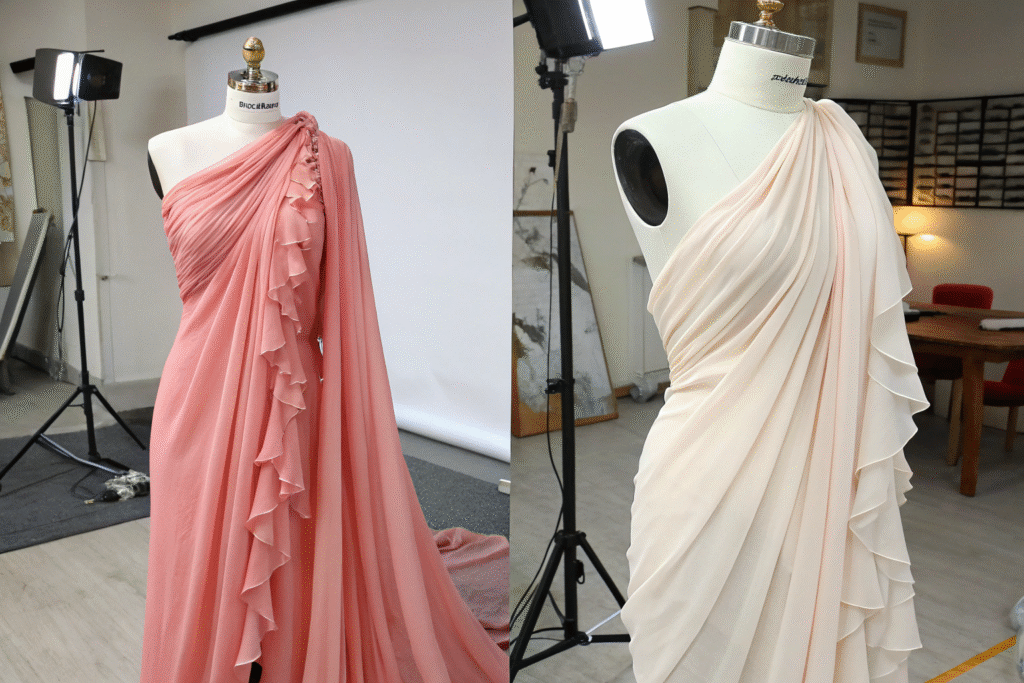
Is Chiffon or Georgette Better for Export Buyers?
For large-scale exports to the U.S. and Europe, georgette is often preferred because customers expect easy-care garments. Textile World reports that brands sourcing for mass markets increasingly favor fabrics that minimize returns and extend garment life.
Chiffon remains essential for luxury niches, but for wider audiences, georgette offers a better balance of fashion and functionality.
Can Both Fabrics Be Used Together?
Yes. Many collections highlighted in Harper’s Bazaar showcase dresses that combine chiffon’s romance with georgette’s durability. This hybrid approach reduces risks for retailers and delivers maximum value for end customers.
For example, chiffon sleeves and overlays add delicacy, while a georgette bodice ensures the garment holds shape. This synergy demonstrates how fabric blending can elevate design without compromise.
Conclusion
Chiffon and georgette may look similar, but they serve distinct needs in fashion. Chiffon is light, sheer, and perfect for bridal and evening gowns where romance matters most. Georgette is textured, durable, and better suited for versatile, embellished, or everyday dresses. The smartest approach often lies in combining them—chiffon for elegance, georgette for structure.
As a professional textile supplier, I have seen firsthand how the right fabric choice impacts sales, returns, and customer satisfaction. If you are planning to create your own fashion collection or need reliable wholesale fabric sourcing, our company Shanghai Fumao can provide chiffon, georgette, and over 30,000 seasonal fabric options. For consultation and bulk orders, please contact our Business Director Elaine at elaine@fumaoclothing.com. We are ready to help you bring your dress designs to life with fabrics that delight your customers.

